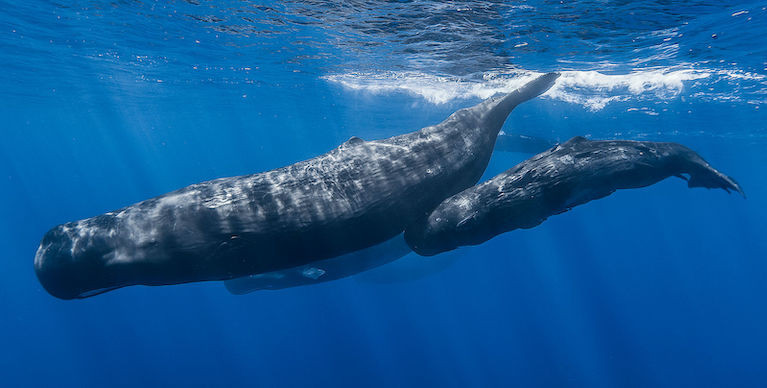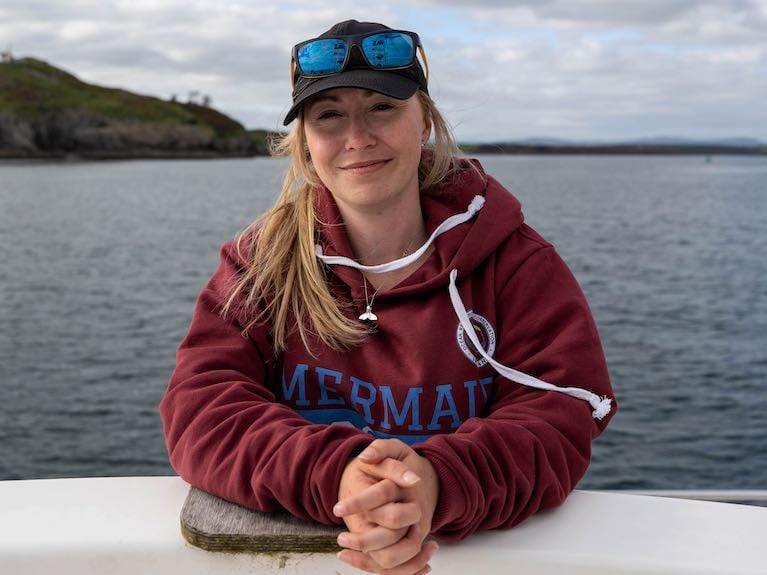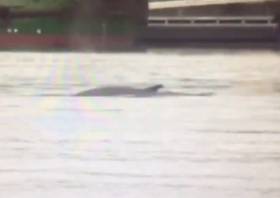Displaying items by tag: Whales
Whale Tales in West Cork as IWDG Gather for AGM in Leap
The Centre of Excellence for Climate Action & Sustainability at Myross Wood House in Leap is the location for this year’s WHALE TALES.
West Cork is a good location for the event, which will start on Friday evening and continue throughout the weekend until Sunday, open to both Irish Whale and Dolphin Group (IWDG) members and the general public.
This annual meeting of the IWDG is an opportunity for all whale (and dolphin) enthusiasts to join us over a weekend to share our appreciation for these charismatic mammals and learn more about the conservation and research work being carried out by the IWDG and others.
This year’s event is being held at CECAS, The Centre of Excellence for Climate Action and Sustainability, the former religious retreat,
The weekend will start with a humpback whale film/ presentation on Friday evening, relevant to anyone living in West Cork who has ever been fortunate enough to see this iconic species. Saturday will be a “Whaley day” of news and stories from IWDG officers and an opportunity to introduce and discuss topics, including offshore renewables and Marine Protected Areas (MPAs), with plenty of time for Q&A. More importantly, this is a great opportunity to share your stories and mingle with like-minded folk, passionate about our marine environment and its wildlife.
The weather will dictate activities on Sunday morning, but the options are to hold a land-based whale watch from a local vantage point or deliver a simulated live-stranding exercise on a local beach or at the venue.
The IWDG AGM is on Saturday afternoon at 17:00, open only to current members More information from IWDG on Email: [email protected]
Stunning humpback whale images have been captured by a postgraduate student east of the Fastnet lighthouse during a research trip off the West Cork coast.
Miguel Blázquez Hervás, a PhD student at the Atlantic Technological University (ATU) in Galway, was on his first trip out to try and sight some humpback whales when he came across a pod of three.
“I arrived down in West Cork last Saturday (May 28) and took the Cape Clear ferry Carrig Mhór,” Blázquez Hervás, from Madrid, Spain, said.
He was participating in a training course run by the Irish Whale and Dolphin Group (IWDG).
“The weather was good but quite windy, so it was a little bumpy. I wasn’t expecting to see anything and when I saw the three whales, along with some common dolphins which were also feeding on schools of fish,” he said.
The vessel was about 10km east of the Fastnet lighthouse at the time.
 The humpback is one of 24 species of whale regularly seen in Irish waters, and there have been over 1,000 validated sightings reported
The humpback is one of 24 species of whale regularly seen in Irish waters, and there have been over 1,000 validated sightings reported
One of the three whales has been catalogued by the IWDG with the identification number HBIRL67, but the other two had no previous records.
The HBIRL67 whale is a female and can be recognised by the tooth rakes on the left side of her fluke, the two lobes of the tail. The rakes may have been caused by an encounter with killer whales.
She has been an annual visitor to Irish waters since 2016, according to the IWDG.
The humpback is one of 24 species of whale regularly seen in Irish waters, and there have been over 1,000 validated sightings reported.
In 2019, the IWDG confirmed a positive match between a humpback photographed at feeding grounds off the Irish south coast in 2015, and an animal photographed at breeding grounds in the Cape Verde Islands off West Africa that year.
Blázquez Hervás’s postgraduate research involves trying to determine the length and body condition of humpback whales in Irish waters using a drone, along with an analysis technique to determine abundance and trends over time.
His postgraduate scholarship is grant-aided by Fundación Mutua Madrileña
Ahead of its broadcast this weekend, Newstalk previews A Sea of Sound, a new radio documentary that explores the impact of noise pollution on marine wildlife.
Marine mammals such as dolphins and whales effectively ‘see’ through sound in the water. “So to understand the life they lead, as the Irish Whale and Dolphin Group’s Simon Berrow says, we need to “think acoustically”.
Producer John Higgins spoke to Berrow and other environmental stakeholders for the documentary, which also features some of the remarkable sounds of whales and dolphins communicating beneath the waves — and explores the sounds that threaten them, from seismic surveys to military sonar and more.
A Sea of Sound will be broadcast on Newstalk this Sunday morning 27 March at 7am, with a repeat on Saturday 2 April at 9pm. It will also be available as a podcast.
Christmas Whales off the Waterford Coast
The Irish Whale and Dolphin Group is reporting a sighting of large Fin Whales close to the shore at Hevlick Head on the County Waterford Coast.
Andrew Malcolm photographed and identified the pod close to shore feeding.
There were at least five animals present in two groups on Christmas Day.
More details from the IWDG here.
Christmas Whales, 5 off co Waterford's Helvic Headhttps://t.co/FjnX1EBb1K
— ? Cork Coast (@CorkCoast) December 26, 2020
Large Fin whales 25th December.
IWDG Images by Andrew Malcolm - IWDG, Cárthach Ó Faoláin#iwdg #whales #whale #waterford pic.twitter.com/Z0q9cLzqf4
Noise of Bottom Trawling Disturbs Marine Mammals, NUIG Study Finds
Whales are known to be disturbed by the noise of ships and oil and gas drilling, but now a new study says that bottom trawling can also upset marine mammals.
As the Irish Independent reports today, scientists at NUI Galway’s (NUIG) Ryan Institute have found that the sound generated by trawling for fish around underwater canyons is amplified and may affect marine mammals’ ability to hunt and navigate.
The team used hydrophones to record the impact on the marine environment of trawlers in two surveys in the Irish Sea and Celtic Sea.
Ecologically sensitive areas of the oceans need stronger environmental protection from the wide variety of potential pollution sources, including ships, deep-sea mining and bottom trawling, the team suggests.
The scientists modelled how the noise generated by bottom trawling could travel through the water column, along the seabed, and through a 20km long submarine canyon in the Porcupine Basin off the south-west Irish coast.
They found the noise funnels through underwater canyons and into deeper waters, affecting marine mammals feeding and migrating.
They also discovered that “modelled trawler sound” generated on the seabed travels underwater more “efficiently” than sound generated at the surface by boats.
Eoghan Daly, a PhD researcher with NUIG’s Irish Centre for Research in Applied Geosciences (iCRAG), said that raised levels of marine noise can “interfere with a marine mammal’s ability to communicate, hunt and navigate using echolocation”
“Human-derived noise in the world’s oceans comes from many sources”, but “ bottom trawling’s impact has received “little attention to date”, he said.
“In an ocean already faced with plastic pollution and climate change, a better understanding of trawler noise pollution will highlight it as another human impact on the marine ecosystem,” Daly said.
The NUIG team’s findings have been published in the scientific journal, Marine Pollution Bulletin.
The team hopes their research will inform improved environmental regulations near key marine habitats, marine protected areas (MPAs) and any additional special areas of conservation in Irish waters.
Ireland has set a target of designating a total of 30% of its maritime area as MPAs by 2030.
“The research fills an important gap in marine noise pollution monitoring,” Dr Martin White of NUIG said.
“Areas such as the Porcupine Basin and the wider European continental margin are ecologically sensitive, and trawlers operating in this part of the Atlantic Ocean have more powerful engines and heavier gear,” he said.
“The enhanced currents and nutrient mixing in these parts of the ocean help create good conditions for cold-water coral mounds and for associated invertebrates, fish and mammals to thrive,” he noted.
Marine life should be protected from the wide variety of pollution sources, including ship noise, pile driving and from bottom trawling, as we now know,” he said.
Read The Irish Independent here
What Impact of Marine Traffic on Whales in Irish Waters? New Study Launched
The waters off the south coast of Ireland have been selected as the study location for Ireland’s first real-time acoustic monitoring project of large whales, with the aim to relay warning alerts to maritime traffic to reduce the risk of disturbance and ship strikes.
The Automated Cetacean Acoustics Project (ACAP) is being undertaken by Ocean Research & Conservation Ireland, a “for-impact” non-profit organisation based in Cork, in partnership with the Rainforest Connection and supported by Huawei Ireland.
Huawei Ireland is providing a research grant with technological support through its global TECH4ALL initiative. TECH4ALL is Huawei’s digital inclusion initiative, using technology, applications and skills to empower people and organisations everywhere.
90% of Ireland’s international trade travels by sea, with the South Coast of Ireland one of the busiest heavy ship shipping lanes in the world. Thousands of large container ships pass through it from Eastern Canada to Liverpool and other European ports annually, as well as additional pleasure boats, speed crafts and eco-tour operators.
The South Coast is also an important foraging, resting and reproductive habitat for 25 cetacean species (whales, dolphins and porpoise) and particularly for large Humpback, Fin and Minke whales. Heavy ship traffic places whales at an increased risk of ship strikes causing injury or even death, and also raises the ambient noise pollution affecting all the species present.
The new study will see the deployment of acoustic monitoring equipment in the Celtic Sea at locations where sightings of whales and other wildlife have been recorded. The equipment will be able to listen for movements of whales, and with the help of machine learning models to enhance data analysis, for the first time provide near real-time detection. This will provide multiple benefits - helping with the identifying and classification of species in Irish waters, their distribution and behaviour, and most importantly, the development of an early warning system that will enable ships to reduce their speed in time to lessen the considerable risk of ship strikes.
The project will see Ireland leading the way in the advancement of policy and programmes that respect and protect marine wildlife informed by near real-time data available for the first time, with the help of Rainforest Connection and Huawei Ireland. Not only will the detections be able to help inform policy and decision-makers in the establishment and management of potential marine protected areas (MPA’s), they will also be used for education and made available to the wider public to hear the symphony of cetacean sounds.
Commenting, lead researcher Emer Keaveney, Marine Mammal Ecologist, Ocean Research & Conservation Ireland said: “Recent advances in technology provide increasing opportunity to use these innovations for good and to enhance our understanding of the natural world. This is such an exciting time as now we have a chance to peer inside the secret world of whales in Irish waters, and directly improve their welfare and conservation”.
“We are a voluntary organisation that relies heavily on third party and private assistance, so we are delighted to have this opportunity to work with Huawei Ireland.”
Emer Keaveney will discuss the project via livestream as part of the annual Huawei Connect summit, which takes place in Shanghai and online between 23rd - 26th September. Emer Keaveney is the only Irish speaker at the summit, which focuses on AI, 5G and digital innovation.
Commenting on the announcement, Tony Yangxu, CEO Huawei Ireland said: “Huawei has been a trusted partner for over 16 years in Ireland, and we are excited to be supporting Ocean Conservation & Research Ireland as our very first fully funded TECH4ALL initiative in Ireland.”
“Huawei believes that no one should be left behind in the digital world and we have made it our mission to put digital inclusion front and centre of our business. Our TECH4ALL programme centers on developing digital inclusion and empowerment initiatives with measureable outcomes. One of its many purposes is to help accelerate the UN’s SDGs and we hope that this project with ORC Ireland can contribute to that.”
The giant whale skeletons of Dublin’s ‘Dead Zoo’ are being dismantled as part of a €15 million project to upgrade the building, as RTÉ News reports.
The remains of a fin whale recovered from Bantry Bay and a juvenile humpback stranded at Enniscrone both date from the Victorian era and have been suspended from the ceiling of the natural history museum for over 100 years.
But from next month the marine wildllife specimens will be removed piece by piece to allow for work on the building’s roof — while other exhibits are also being relocated amid work to improve accessibility.
"We are definitely facing a unique challenge,” said Nigel Monaghan of the National Museum of Ireland - Natural History, who added: “Only a handful of people have done this in other parts of Europe over the past decade.”
RTÉ News has more on the story HERE.
‘Whale’ Spotted In River Liffey At Dublin Port
Update Friday 4 October: RTÉ News is now reporting that the whale, now identified as a 25ft fin whale and believed to be a juvenile, was found dead in Dublin Port this morning.
RTÉ News reports on a suspected whale sighting at Dublin Port this afternoon (Wednesday 2 October).
The 20-foot whale, estimated to be some 20 feet in length, was filmed blowing from its blowhole numerous times while swimming near the Stena berth.
Cetaceans rarely make appearances in the city. In November last year a common dolphin brightened a dreary winter’s day for city centre commuters when it swam as far as the Loopline Bridge.
There she/he blows.... spotted in the Liffey. More on @rtenews pic.twitter.com/qepBEoMwgC
— Conor Hunt (@conorfhunt) October 2, 2019
Elsewhere, humpback whales have now been sighted in Donegal Bay, much further north than their usual haunts off the Cork and Kerry coasts.
The Irish Whale and Dolphin Group (IWDG) says records from the 22 and 24 September respectively represent the first for humpbacks in the area since the summer of 2008.
UK’s Natural History Museum Releases Decades Of 20th Century Whale & Dolphin Stranding Records
#MarineWildlife - The UK’s Natural History Museum has made available for the first time a vast trove of whale and dolphin stranding records in British and Irish waters.
The data covers the years 1913 to 1989, filling in a significant gap before the Irish Whale and Dolphin Group’s stranding scheme began in 1991.
Over the years many entries were submitted by the coastguard, fishermen and members of the public — including a detailed record of a harbour porpoise found in Co Cork in 1913, the very first card in the data set.
PhD candidate Ellen Coombs is combing through the records to determine what picture “one of the longest systematic cetacean stranding data sets in the world” reveals for the status of cetacean species in our waters.
And already there have been some important finds, such as occasional records of deep-diving Cuvier’s beaked whales over the decades — not to mention a double stranding of narwhals in 1949.
The data also correlates with already known trends, such as the sharp decline in blue whale records with the expansion of commercial whaling in the early 20th century.
The Natural History Museum website has more on the story HERE.
Whale & Dolphin Strandings In Cork This Week ‘Only A Percentage Of What Is Actually Dead At Sea’
#MarineWildlife - Unusual weather for this time of year may be responsible for a recent spate of whale and dolphin strandings on the Cork coast in the past week.
The Irish Examiner reports that among the eight strandings were the carcass of a sperm whale on Long Strand in West Cork and a dolphin with fishing line around its beak in Schull.
However, the Irish Whale and Dolphin Group’s (IWDG) Mick O’Connell said that while the statistic was high within such a short timeframe, it was not necessarily a mystery.
“We normally get the same thing every year,” said the IWDG stranding officer. “It is usually more in the southwest and west, but this year, I suppose we have had more southeast winds, which probably explains it.”
O’Connell added that the strandings are “only a percentage of what is actually dead at sea” — and that post-mortems may “shed some light in their deaths”.
The Irish Examiner has more on the story HERE.



































































